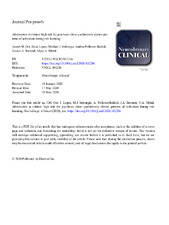| dc.creator | Orr, Joseph | |
| dc.creator | Lopez, Jesus | |
| dc.creator | Imburgio, Michael | |
| dc.creator | Pelletier-Baldeli, Andrea | |
| dc.creator | Bernard, Jessica | |
| dc.creator | Mittal, Vijay | |
| dc.date.accessioned | 2020-05-27T13:30:49Z | |
| dc.date.available | 2020-05-27T13:30:49Z | |
| dc.date.issued | 2020 | |
| dc.identifier.citation | Orr, Lopez, Imburgio, Pelletier-Baldeli, Bernard, & Mittal (2020). Adolescents at clinical high risk for psychosis show qualitatively altered patterns of activation during rule learning. NeuroImage: Clinical. doi:10.1016/j.nicl.2020.102286 | en |
| dc.identifier.uri | https://hdl.handle.net/1969.1/188023 | |
| dc.description.abstract | Background
The ability to flexibly apply rules to novel situations is a critical aspect of adaptive human behavior. While executive function deficits are known to appear early in the course of psychosis, it is unclear which specific facets are affected. Identifying whether rule learning is impacted at the early stages of psychosis is necessary for truly understanding the etiology of psychosis and may be critical for designing novel treatments. Therefore, we examined rule learning in healthy adolescents and those meeting criteria for clinical high risk (CHR) for psychosis.
Methods
24 control and 22 CHR adolescents underwent rapid, high-resolution fMRI while performing a paradigm which required them to apply novel or practiced task rules.
Results
Previous work has suggested that practiced rules rely on rostrolateral prefrontal cortex (RLPFC) during rule encoding and dorsolateral prefrontal cortex (DLPFC) during task performance, while novel rules show the opposite pattern. We failed to replicate this finding, with greater activity for novel rules during performance. Comparing the HC and CHR group, there were no statistically significant effects, but an effect size analysis found that the CHR group showed less activation during encoding and greater activation during performance. This suggests the CHR group may use less efficient reactive control to retrieve task rules at the time of task performance, rather than proactively during rule encoding.
Conclusions
These findings suggest that flexibility is qualitatively altered in the clinical high risk state, however, more data is needed to determine whether these deficits predict disease progression. | en |
| dc.description.sponsorship | This work was funded by the National Institute of Mental Health R01MH094650 to V.A.M.. J.M.O. was supported by F32DA034412 and by start-up funds from Texas A&M University. J.A.B. was supported by NIH F32MH102898, a Brain & Behavior Research Foundation NARSAD Young Investigator Award as the Donald & Janet Boardman Family Investigator, and by start-up funds from Texas A&M University. | en |
| dc.language.iso | en_US | |
| dc.publisher | NeuroImage: Clinical | |
| dc.rights | Attribution-NonCommercial-ShareAlike 4.0 International | en |
| dc.rights.uri | http://creativecommons.org/licenses/by-nc-sa/4.0/ | |
| dc.subject | high risk | en |
| dc.subject | psychosis | en |
| dc.subject | fMRI | en |
| dc.subject | executive function | en |
| dc.subject | rule learning | en |
| dc.subject | neuroimaging | en |
| dc.title | Adolescents at clinical high risk for psychosis show qualitatively altered patterns of activation during rule learning | en |
| dc.type | Article | en |
| local.department | Psychology | en |
| dc.identifier.doi | 10.1016/j.nicl.2020.102286 | |



